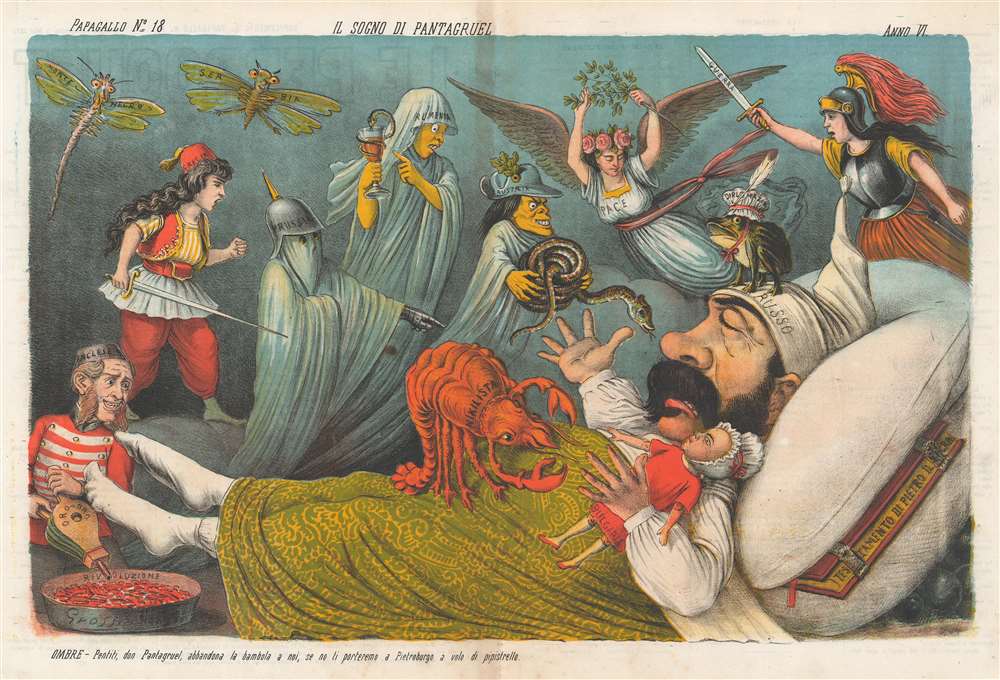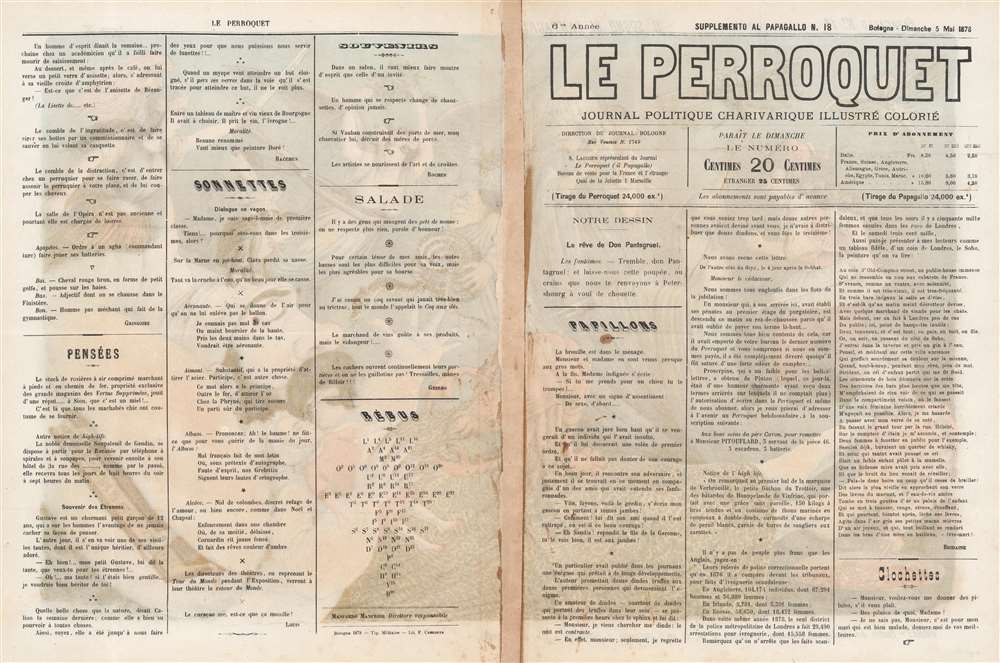1878 Grossi Political Cartoon of Russia as Pantagruel Having Nightmares
SognoPantagruel-grossi-1878
Title
1878 (dated) 15 x 21.75 in (38.1 x 55.245 cm)
Description
A Description of the Cartoon
Entitled 'Pantagruel's Dream', Russia as Pantagruel (his nightcap is labeled Russo) sleeps with his blanket unable to cover his enormous body. Czar Peter the Great's 'testimony' is under his pillow and he holds a doll labeled Bulgaria. A frog wearing a hat labeled 'Diplomacy' sits on Russia's head. Ghastly, nightmarish figures surround him. A gigantic lobster labeled 'Nikilista' sits on his torso, while a witch identified as Austria appears to be handing him a coiled snake. The ghost of Romania holds what can only be a poisoned chalice, while a Prussian ghost in armor and helmet points directly at the sleeping Russia. England, kneeling near the foot of Russia's bed, fans the coals of 'Revolution' below Russia's exposed feet, while a young Greece brandishes a sword in Russia's direction. Serbia and Montenegro are bugs flying above the melee, watching the events. War and Peace appear above Russia's head, evoking the two possible avenues that Russia could follow in the wake of the Russo-Turkish War. The caption (written in Italian) reads, 'OMBRE, Pentiti, don Pantagruel, abbandona la bambola a noi, se no ti porteremo a Pietroburgo a volo di pipistrello'. Translated into English, this roughly means, 'Shadows (ghosts) - Repent Don Panagruel, leave the doll to us, otherwise we take you to Petersburg at bat's flight.'Analysis and Historical Context
This cartoon was published two months and two days after the end of the Russo - Turkish War (1877 - 1878). The Russians, leading a coalition of Bulgaria, Montenegro, Romania, and Serbia, won the war and regained the territory they lost during the Crimean War (1853 - 1856). The Treaty of San Stefano, which ended the war, established an 'independent' Bulgarian state within the Ottoman Empire. Per the terms of the treaty, Bulgaria became the autonomous, although it remained a de jure tributary of the Ottoman Empire. Under the terms of the treaty, Bulgaria would receive land on the Black Sea and the Aegean Sea, which appeared very tempting to the Russians. It is unclear how much influence the Russians had over the Bulgarians and if the Bulgarians would be willing to allow the Russians to use this land for navy bases. A port with access to the Mediterranean had been on Russia's wish list for a long time, since the reign of Peter the Great. One of the other terms of the treaty stipulated that Ottoman troops had to withdraw from Bulgaria but that Russian troops would remain for another two years. The fact that Russia would have significant influence in Bulgaria made the Western European powers nervous, leading to this cartoon and its message of beating the Russians at all cost.Russo-Turkish War (1877 - 1878)
The failure of the Berlin Memorandum led Russia to declare war on the Ottoman Empire in 1877. Russia recognized the conflict as an opportunity to seize desirable territories along the Black Sea and potentially Istanbul itself - and, with this territory, port access to the Mediterranean and Atlantic, a long-time sticking point for Imperial Russia. Russia won victory after victory, driving hard towards Istanbul. Britain, fearing increased Russian power in Turkey might threaten British dominance in Central Asia, convinced Austria and Germany to intervene. They forced Russia to the negotiating table. Hostilities formally ended with the March 3, 1878, Treaty of San Stefano, which stipulated independence to Romania, Serbia, and Montenegro; autonomy to Bulgaria; reforms in Bosnia and Herzegovina; and ceding Dobruja and parts of Armenia to Russia alongside a large indemnity.Publication History and Census
This cartoon was created by Augusto Grossi and published in the Sunday May 5, 1878, edition of Le Perroquet, the French version of Il Papagallo. We note a single cataloged example, which is part of the collection at the Library of Congress.Cartographer
Augusto Grossi (September 23, 1835 - 1919) was an Italian designer, painter, caricaturist, and publisher active in Bologna in the latter part of the 19th century and early 20th century. He studied at the Bologna Academy of Fine Arts and participated in exhibitions in 1855 and 1856. He developed a technique for drawing on lithographic stones using a fat-based pencil. Grossi's first caricature work was in the biweekly Il Diavolo Zoppo, published with Leonida Gioannetti (18?? - January 4, 1897), between 1863 and 1865. Later, in 1865, he and Gioannetti began publishing a similar satirical newspaper, La Rana (1865 - 1912). La Rana was published in Bologna and known for its highly graphic monarchist satirical commentary on European politics. La Rana was initially only in Bologna, but quickly received national attention due to Grossi's brilliant satirical illustrations and irreverent tone. After 1879, the satirical centerfold was printed in color, further popularizing the weekly. A French edition, La Grenouille, was published from 1872, but promptly censored as subversive when it published a biting caricature of French President Adolphe Thiers. In 1873, Grossi left La Rana to publish his own magazine, Il Papagallo, dedicated exclusively to international politics. Il Papagallo was particularly popular for its regular and stunning chromolithograph centerfolds. A French version of Il Papagallo Le Perroquet was launched in 1876, and an English edition, The Parrot, launched in 1879. The foreign editions maintained the same centerfold but had more regionally appropriate text. While the English edition never attained much traction, the French edition Le Perroquet eclipsed the Italian edition in sales. In 1915, when Grossi's decline in health and World War I made publication impractical, all editions of Il Papagallo ceased. All of Grossi's newspapers consisted of a single broadsheet, which folded in half made 4 pages, including a 2-page centerfold. He also collaborated with the Greek magazine Aristophanes, providing 4 color lithographs for 11 years. In 1910 Grossi donated his lithographic stones to the Archiginnasio of Bologna. At his death in 1919, the Resto del Carlino commemorates him: 'an old-fashioned gentleman, cheerful and humorous … solitary, beloved of the family.' More by this mapmaker...




